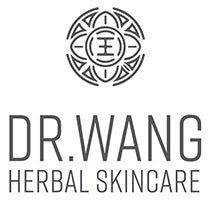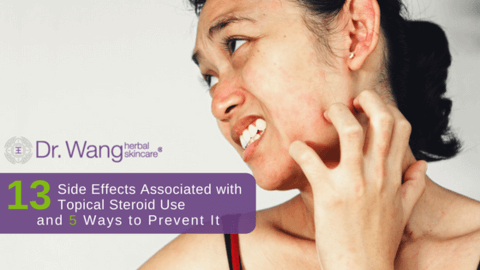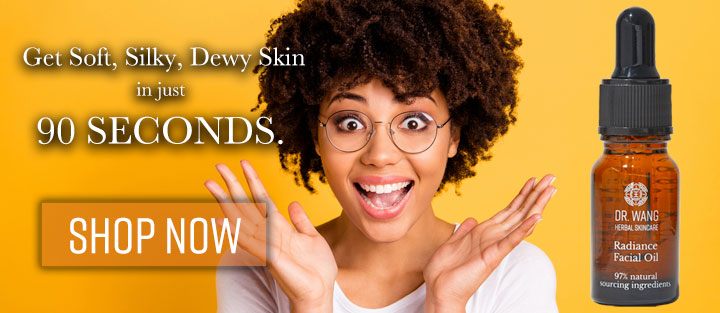
Topical steroids are a common medication used to treat many types of skin diseases. When steroids were first used by dermatologists over 50 years ago, it was considered as a game changer for many patients with all sorts of skin diseases, such as eczema and psoriasis, got better. The steroid medications work mainly by shutting down the inflammation and suppressing the immune cells in the skin.
You may have suspected that like the steroids you take by mouth, application of steroids on skin can have potential side effects such as easy bruising, acne, and spider veins.
You are correct!
The risk of getting these side effects depends on 1) the strength of steroids, 2) type (e.g., lotion, creams, ointment, or foam) of steroids, 3) frequency and duration of use, and 4) where you are putting on the body
Here are 13 top side effects associated with topical steroid use. Most importantly, we want to share 5 easy ways to prevent and limit these side effects.
- Atrophy: Skin atrophy is defined as thinning of the skin, and this is by far the most common side effect. It is generally accepted that all topical steroids can cause atrophy after prolonged use. Clinically, the atrophic skin tends to be more transparent, thinned, and fragile. It is believed that steroids suppress the cell growth and inhibit collagen production, which leads to the thinning of the skin.
- Telangiectasia is defined as an increase in number and size of small blood vessels on the skin. Typically, blood vessels are not easily seen on the skin. Because of thinning of the skin, the blood vessels become more visible. In addition, steroids stimulate the growth of endothelial cells (cells that create the lumens of the blood vessels), which lead to increased proliferation of blood vessels.
- Epidermal barrier disturbance: The skin provides a protective barrier between our body and environment. Our skin not only prevents bacteria and allergens from entering our body, but it also regulates temperature and water content. Steroids can damage the skin barrier resulting in an increased penetration of allergens and bacteria into the deeper layers of skin and body resulting rash and infection, respectively. Also, damage to the skin barrier can make skin disease such as eczema worse.
- Steroid rosacea is defined as redness on the nose, cheeks, forehead, and chin. This symptom occurs when the steroid is used over a very long course period. Usually, middle-aged women experience this side effect. As mentioned before, topical steroids can thin the skin and increase in number and size of blood vessels. The end result is an increased redness on the face.
- Acne is a well-known side effect of topical steroid use. Steroids, at first, suppress inflammation of papules (small or raise pimples). Interestingly, short-term use of steroids can suppress inflammation seen in acne. However, prolonged use of steroids can trigger the flare of acne. This usually occurs on the face.
- Perioral dermatitis occurs when the long-term use of topical steroids that leads to small, raised pimples and pustules around the mouth and chin. These raised pimples are commonly seen on women. In some instances, it has been seen on men and children as well (50).
- Steroid addiction: Some people who use topical steroids can become addicted to the medication. Steroid can initially calm down the inflammation and make skin diseases such as acne and rash disappear. For fear of the skin rash returning or getting worse when the medication stops, some people would not stop using it. Over prolonged use, steroids will definitely make skin worse. In severe worse case, patients may present as the “red burning skin syndrome.” (28).
- Hypertrichosis refers to abnormal growth of small, thin and short hair on the cheek and upper lip. These are called vellus hair, which is very different from the long thick hair on our scalp. It is unclear why steroids trigger the growth of these small vellus hair. Although this side effect is more commonly seen in taking steroids by mouth, topical steroids can occasionally cause this side effect as well(56, 57)
- Hypopigmentation is defined as a decrease in pigmentation or coloration of the skin (58). Steroids are known to suppress the production of melanin in the skin. This side effect is especially noticeable in African or sub-Saharan African individuals (58). These skin discolorations are typically reversible once the steroid is no longer used.
- Purpura, stellate pseudoscares, and ulcerations: Purpura refers to bruising, whereas stellate pseudoscares is white scarring that usually occurs on sun-exposed skin. In most cases, these side effects are commonly seen on the arms and legs. These symptoms occur because blood vessels lose their surrounding collagen and elastin, supporting structures in the deep layer of skin. Lesions may result, but this side effect is usually present when severe steroid use occurs. Purpura commonly causes spotting to produce on the skin,
- Infections: skin infections are common in patients receiving steroids treatment. It was estimated that the skin infection occurs between 16% to 43% of users (12) who use steroids. In addition to bacterial infection, one can also have yeast and fungal infection.
- Delayed wound healing: Normal wound healing is a complex and carefully orchestrated process. Steroids interfere and inhibit the normal wound healing process. Steroids inhibit fibroblasts (cell deposit collagens) and keratinocytes (cell in the first layer of skin) causing thinning of skin and poor wound healing.
- Contact allergy to topical steroids: Steroids is often the first line of treatment for people with allergy or rash. However, some people can become allergic to steroid use. While rare, its effects can be serious, as people tend to believe their rashes are getting worse and apply more steroids with each use (17, 18). The end result is the continued exposure worsens the skin disease. If you notice a reaction, such as an unusual amount of redness, itching, or burning sensation on or around where the topical steroid is applied, make sure to stop the use of the steroid.

Special Concerns On the Use of Topical Steroids In Kids
Children have particularly sensitive skin compared to adults (19, 20). There is a greater chance for children to have side effects associated with steroid use.
The British National Formulary warns that children especially susceptible to side effects when using topical steroids. The organization recommends that steroids should be avoided, if possible, It also advocates to use steroids for short periods.
The US Food and Drug Administration conducted a review of 24 most common topical steroids used for kids between the ages of 0 and 18 years old. Their results showed there were over 202 reports of adverse effects seen.
The study showed that mean age of patients who experienced side effects was 7.7 years old and the onset of side effects occurred after using steroid for169.3 days (21). In many of these cases, the topical steroid was applied to the face and neck. In general, most side effects were described as local irritation, skin discoloration, and scarring. However, there were reports of severe side effects were also observed.
Preventing Side Effects of Topical Steroids
In order to limit and prevent side effects associated with topical steroids, here are 5 useful tips you should follow (110, 25, 112):
- Seek physicians order to use the appropriate strength of topical steroid.
- Get clear instruction on the frequency (e.g., apply once or twice per day) and duration (e.g., 3 months only) of using the topical steroids.
- Do not end steroids abruptly. Consider tapering or reducing the strength and frequency of steroids when skin diseases start to improve.
- Also, consider switching to low-potency steroids if skin diseases are improving. Don't forget to use moisturizer, such as the 2017 Good Housekeeping Seal winning - Herbal Rescue Balm.
- Pay close attention to common side effects listed above. When seeing these adverse effects, be sure to inform your physicians
Overall, it is important to pay attention to where the topical steroid is being applied and how frequently the application is being used. With careful application, side effects may be reduced.
Different Strengths of Topical Steroids
Before we conclude, it is important to know that topical steroids are not just one drug. Instead, there are over 50 different types of medications. Aside from the type of forms (e.g., lotion, gel, cream or ointment), another major distinction of these drugs is their strength or potency.
Potency is measured by various tests:
Vasoconstriction test: this test examines the efficacy of steroids in inducing blood vessels to close and narrow (21).
Ultraviolet erythema test: a topical steroid is applied 24 hours prior to the exposure of ultraviolet rays. Just seven hours into the exposure, redness is examined and treated sites are compared to untreated ones (5).
Skin atrophy test: this exam looks for areas where the skin seems to be wasting away. The topical steroid gets applied to a specific area on the skin for 3 weeks and is given a score to rank the intensity of the side effect (7).
Depending on the location, the severity of rash and age of the patients, your doctor may prescribe different types of steroids. In general, for severe and extensive skin diseases, more potent steroids will be prescribed.
This is a double-edged sword, meaning that stronger steroids are more effective in treating skin diseases. However, it also means that you will more likely to get the side effects.
Final Thoughts
When topical steroids are used properly they can work wonders and have little side effects (27). Unfortunately, like all drugs, steroids have many side effects. So, have you ever used topical steroids? What were your results? Do you know anyone who is currently using steroids for long period of time? If so, please share this article and let them know about the potential harms associated with this class of drugs.
Read This Next Article about Topical Steroids Withdrawal






When I have significant flare-ups of Erythema multiforme minor on my hands, I apply Triamcinolone Acetonide Ointment 0.1%, usually multiple times. Could this exacerbate sleeping problems? I also take simvastatin and venlaxafine. Typically, I’m a light sleeper. Can you recommend an alternative to the topical corticosteroid? Thanks.
I have been taking steroid based oral ointment to treat my oral ulcer. Now I’m developing skin discoloration on the left cheek where I applied the ointment in the inner side. Is there any connections? Should I stop the ointment?
I m a hypothyroidism (thyroid)age 47, patient my skin is very dry and my city climate is also dry. I have malasama on cheeks and nose as i was using a cream which had steroids which cause redness and spider veins as i stoped my face skin has become very dark plz advice me so that my complexion gets fair as it was plz plzplz reply
Do you have a cream that can help with ACL and meniscus recovery surgery
Thanks dear for sharing such beautiful information with us.But here I have a very quick question that How we can realize our types of skin ? Hope soon you will write a detailed article to give a complete info about my question.
Best Regards